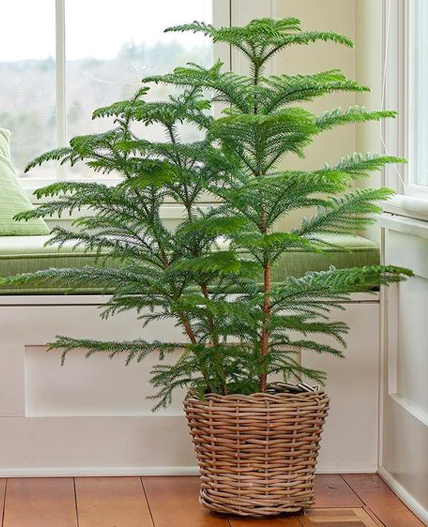
NORFOLK ISLAND PINE NEEDS TLC

Beavercreek Garden Center:
Mon.-Sat: – 9am-5pm
Sun: – 11am-5pm
CLOSED: July 4th
2074 Beaver Valley Rd
Beavercreek, Ohio 45434
Ph: (937) 427-4110
Wholesale: (937) 426-5729
Centerville Garden Center:
Mon.-Sat: – 9am-5pm
Sun: – 11am-5pm
CLOSED: July 4th
6000 Far Hills Ave
Centerville, Ohio 45459
Ph: (937) 434-1326
Landscape: (937) 274-1154


The Norfolk Island pine has grown in popularity as a live indoor Christmas tree. Its lush green twigs of soft needles provide a lovely backdrop for festive holiday ornaments. Garden centers and mass merchandisers have an impressive selection, ranging from compact desktop plants to large floor plants rivaling a traditional holiday tree!
Unlike most pines that are familiar to Midwesterners, the Norfolk Island pine is far too tender to plant outdoors in our climate. But the good news is that it makes an elegant houseplant when given proper care.
The ideal indoor climate for this species is cool and bright, responding well to daytime temperatures ranging from 60-70 F and slightly cooler at night. Although the Norfolk Island pine will adapt to bright indirect light, the plant will look its best with a couple of hours of direct sunlight daily. If the light source is coming from just one direction, you’ll want to rotate the plant a quarter turn weekly to keep it from tilting toward one side.
When the plant is actively growing, feed it with a fertilizer formulated for indoor foliage plants. It is not unusual for the plant to be in a period of rest during the winter months, at which time there is no need to fertilize.
Water the plant when the top inch or so of the soil in the pot feels dry. Use enough water to allow a little excess to escape through the bottom drainage holes. Discard remaining drained water after about 15 minutes.
What is most challenging for the typical home gardener is giving this plant the high relative humidity it needs. Norfolk Island pine thrives at 50 percent relative humidity, yet it is not unusual for the average house to drop to 15 percent during the winter heating season, unless steps are taken to increase moisture in the air. Running a humidifier will increase both people and plant comfort and is the most effective way to adequately raise the humidity.
It is not unusual for a few needles on the lowest branches to turn brown and drop. If this happens slowly over time, it’s likely just normal aging of the branches or possibly from lower light availability. However, if many needles are browning, or if the problem appears more widely distributed among the branches, look to problems of either too much or too little water or too little relative humidity. B. Rosie Lerner Extension Consumer Horticulturist, Purdue University, 12.31.2003